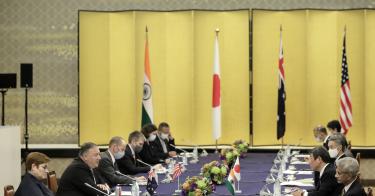An attempt to organize a quadrilateral grouping of Indo-Pacific democracies in 2007 proved to be short-lived. The revival and reinvigoration a decade later of what is termed the Quad was a key foreign policy success of the Trump administration.
Sparked by shared concerns about China’s rise and its increasingly aggressive foreign and national-security policies, the Quadrilateral Security Dialogue today exists as a forum for annual meetings among officials from Australia, Japan, India, and the United States. It is a platform to discuss common challenges and promote greater strategic cooperation.
During the 2020 presidential campaign, it was an open question whether candidate Joe Biden would sustain the Trump administration’s commitment to the Quad. Although the initiative enjoyed support from a broad cross-section of U.S. national security experts and three of America’s key partners in the region, the Obama administration had shown little interest in the Quad. Might a President Biden break with the initiative, or at least substantially alter it, returning to the more accommodating patterns established by President Obama?
>>> The Quad 2.0: A Foundation for a Free and Open Indo–Pacific
It appears not. In just its first few weeks in office, the Biden administration has arranged a Quad foreign ministers meeting and an unprecedented Quad leaders summit. On Feb. 18, the top diplomats of the four democracies met for a virtual ministerial meeting of the Quad. It was a welcome development, although not entirely unexpected. In the weeks before the meeting, senior Biden administration officials had praised the group and its critical role in advancing U.S. interests and strategy in the Indo-Pacific.
On Jan. 29, National Security Advisor Jake Sullivan said of the Quad: "We really want to carry forward and build on that format, that mechanism, which we see as fundamental, a foundation upon which to build substantial American policy in the Indo-Pacific region."
In his Feb. 8 phone call with Indian Prime Minister Narendra Modi, Biden agreed to promote a "stronger regional architecture through the Quad." That was a new formulation. It will be interesting to see how the president intends to use the Quad to strengthen the regional security architecture.
After February’s ministerial meeting, the various readouts from the four governments mirrored previous statements from the group. They emphasized a shared commitment to a free and open Indo-Pacific and a rules-based order; support for ASEAN centrality and freedom of navigation; and a pledge to enhance cooperation on COVID-19 responses, counterterrorism, maritime security, humanitarian aid, climate change, supply chain resilience, cybersecurity, and more.
Notably, each Quad member also expressed concern about the recent military coup in Myanmar and affirmed their support for a democratic transition there. The group also committed to meet at least annually at the ministerial level.
Last week, Australian Prime Minister Scott Morrison announced the leaders of the four Quad countries would hold the first-ever Quad summit in a virtual meeting expected to convene later this month. Such a summit would mark yet another substantive step forward for the group of democracies, sending a powerful signal to foreign and domestic audiences that the Quad enjoys the endorsement and support of the highest levels of leadership. Morrison suggested face-to-face meetings would follow the virtual summit and become a regular feature of Indo-Pacific diplomacy.
A Quad summit would represent the culmination of a remarkable two-year stretch for the group. In 2019, the four capitals “upgraded” the Quad: In addition to annual meetings at the working level (assistant/joint secretary), that year a second Quad meeting was held at the ministerial level (foreign minister/secretary of state). Mid-ranking diplomats and embassy officials from the four democracies also meet periodically in non-Quad countries. In 2019, the group further broadened its agenda to include a joint counterterrorism exercise.
In 2020, the Quad countries held their first quadrilateral naval exercise in over a decade. Last year also saw the emergence of a Quad-Plus group of seven countries—adding South Korea, Vietnam, and New Zealand—that organized over regular videoconference calls to coordinate responses to the COVID-19 pandemic.
Remarks this month from the British High Commissioner to India suggested the United Kingdom is amenable to joining the Quad if the group ever decides to open its membership. Finally, the Australian government has sponsored a new program at the Australian National University to establish a “Quad tech network” to promote collaboration among think tanks and research institutes from the four countries on cybersecurity and critical technology issues.
Just as the Biden administration appears to be going all-in on the Quad, so too is cornerstone of the democratic grouping. It is perhaps no coincidence the Quad met against the backdrop of another crisis in China-India relations, and another standoff at their disputed border. While it appears headed toward at least a limited de-escalation, this crisis was unlike the numerous border crises that preceded it. The first deadly exchange at the Line of Actual Control in over four decades has pushed the relationship further down the path of rivalry and broadened India’s strategic horizons.
It was just one month after the resolution of their last major border crisis, the 2017 standoff on the Doklam plateau, that India finally supported the idea of reviving the Quad. This followed years of lobbying from Australia, Japan, and the United States.
>>> Democracy’s Squad: India’s Change of Heart and the Future of the Quad
The growing frequency of border standoffs, China’s push into South Asia and the Indian Ocean, China’s growing patronage toward Pakistan, and India’s relative estrangement from Russia are all pushing New Delhi away from its non-aligned past. Fear of alienating China no longer prevents India from more fully embracing the Quad. "The Chinese are not particularly sensitive to our concerns regarding [the China-]Pakistan strategic nexus,” notes former Indian Ambassador to China AK Kantha. “Why do we have to be overly concerned about China's sensitivities with regard to the Quad?"
This evolution in New Delhi’s strategic thinking matters a great deal because India is central to the Quad. The group can only move as quickly as its most reluctant member. Japan, Australia, and the United States are already bound by the thickest of security and intelligence bonds. With India involved at a higher level of strategic coordination, this potent democratic triangle becomes a quadrilateral colossus, accounting for half of the planet’s defense spending, and a third of its population and GDP.
With India and the Biden administration now firmly on board, the Quad’s future is bright.
This piece originally appeared in RealClear World




